Words by Oli ‘I like these’ Hulme
Photos by James Archibald
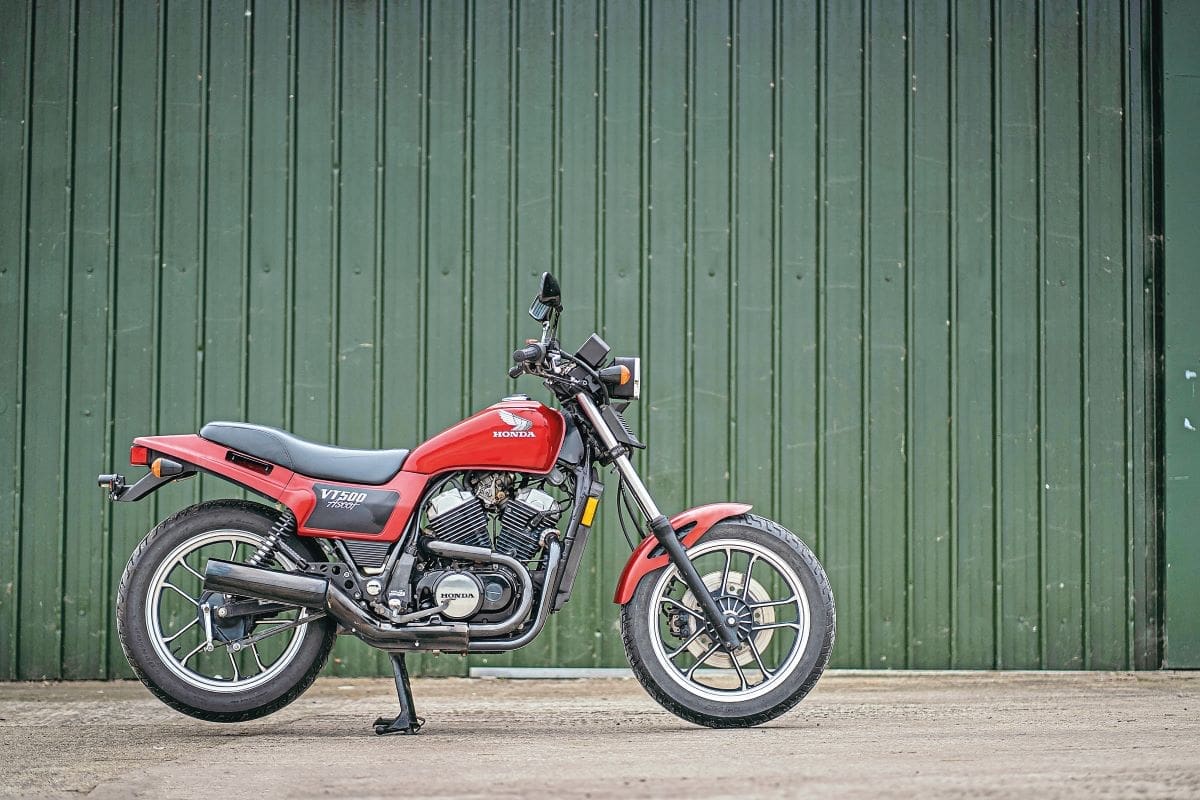
Any used import is an unknown quantity of variable quality. Some need little more than an oil change, a wipe-down, and a battle with the DVLA to get a registration number. My own BSA Starfire was one of those. It’s broken down many times since then, but that’s more to do with it being a late-1960s BSA than anything a transatlantic owner had inflicted. At the other end of the scale are bikes like a mate’s Kawasaki four, bought unseen from a far-away importer. It became a money pit, resulting in a four-year battle to get it to run properly.
The VT500FT Ascot seen here is clearly one of the former, with the benefit of not being built by horny-handed sons of toil in Small Heath with worn-out tools. With just 14,000 miles on the clock, this flat-track (the FT in the name) wannabe has been broken in but barely worn. It doesn’t appear to have been close to a dirt track, let alone a flat one. It’s original, right down to the tool kit, which has sat in its lockable box behind the engine untouched since the Honda rolled out of a showroom in 1983. This will come in handy for a future owner, as it includes a special box-type plug spanner of the correct dimensions to remove the hidden rear cylinder second plug from its cramped location under the petrol tank. The spare fuses are there, too.
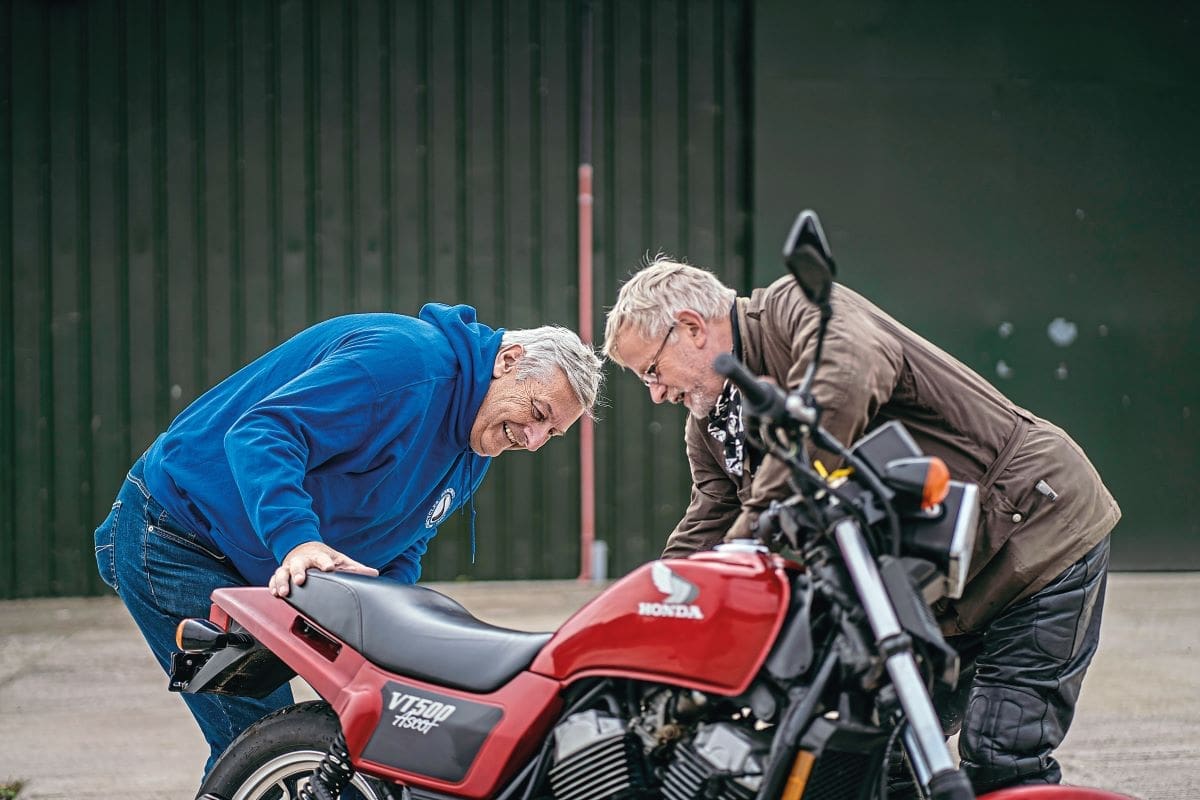
An untouched toolkit is not only a bonus for the searcher after originality, with original kits reaching stratospheric prices among collectors; it also means that the bike has almost certainly been barely touched by its original owner… meaning it’s a perfect runner, or suffered a mechanical calamity and was parked up in despair. In this case, it is fortunately the former.
As I have a taste for the odd, the Ascot tickled my fancy the moment I first saw it, and this is from someone who did not look back with much fondness on an FT500 single of the same vintage.
Paint on the metal bits and side panels was still showroom-fresh, though elsewhere the baking sun of sub-tropical Illinois (for US readers, this is a gentle British witticism) had dulled the red paint on the tailpiece and crazed the finish on the front mudguard tip. The Japanese Dunlop tyres were soft, deep treaded, and looked to have been fitted fairly recently. If they were original, the lightweight Honda wasn’t putting a lot of wear on them. The black exhaust chrome was similarly spotless. Whoever had owned this VT had looked after it.

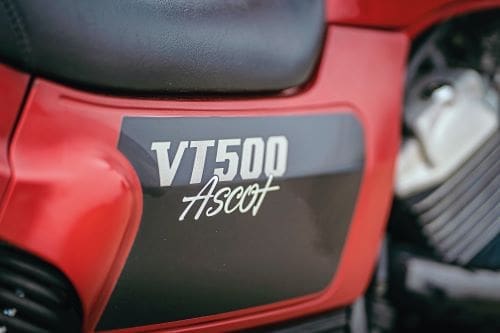
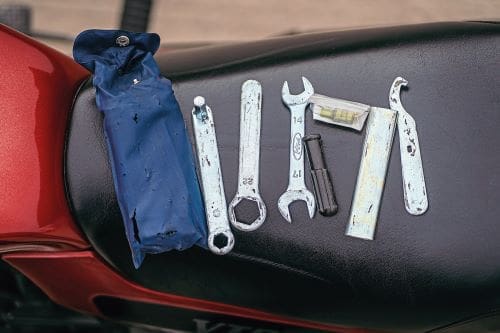
The seat is tall at 31 inches, while the footpegs are high, which makes the riding position a tiny bit cramped for the taller rider. That seat is broadish, thinnish, and a pillion would need to be a very close friend of the pilot. Check out the clocks, too. With a very period look, you are either going to love them or hate them. I thought they looked great, in a sort-of Top Gun jet fighter-style way. However, most would agree on the plastic guard below the headlight being ugly as sin. I liked the indented rear pillion handles on the tailpiece, which had studs hidden inside for attaching bungee straps.
A push of the button had the Ascot purring away. Familiarising myself with the controls, the Honda switchgear is as good as it ever got, with a left-hand mounted choke lever in exactly the right place on the left-hand bar, rather than requiring the rider to fossick around under the tank or take a hand off the ’bars to pull or push a centrally mounted cable.
Those ’bars were upright and narrow, which rather put the mockers on using it as a real flat tracker, where you would want wider ’bars to heave yourself round a dirt oval while kicking the back wheel out. On the road, it’s clear from the noise that it’s a V-twin, but it doesn’t vibrate beyond a barely perceptible buzz. The rear shaft is perfectly balanced, with none of the torque reaction that more primitive shafts provide when increasing or decreasing acceleration. The gearbox is a Honda – which is to say near perfect. I’m not sure if it really needs six gears, but we’ll let that go. It’s as light as a feather, easy to chuck about, accelerates like a good ’un with no driveline lag, and will go round the tightest of corners without frightening even this hefty rider.
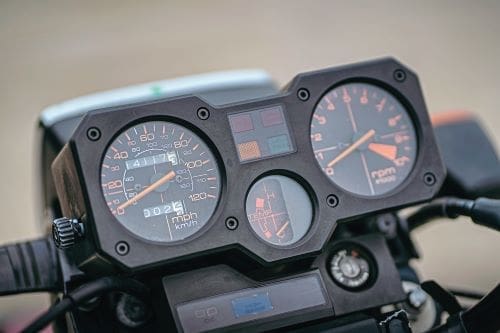
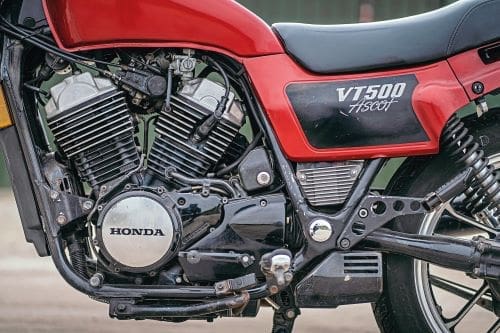
It’s said that when the Ascot appeared in US showrooms, the dealers and the journalists of the time did not really know who it was for. The tank is too small for a tourer, the trim is possibly a little too fragile for a serious off-roader, and there are flashier ways of going faster. It would be a great in-town bike, being ultra-narrow. It excels at back-road lunacy, and if you rode it hard enough to ground the pegs, you would be about to fall off. Fast enough to get you into trouble, well braked enough to get you out of it, the Ascot is a curious, slightly lovable beast. You’ll rarely see another in the UK, but Honda did sell a lot of VT500s, and a lot of the mechanical spares would be interchangeable. Bodywork and cosmetics would be harder to find.
Want something truly different? Pop down to Somerset Classic Motorcycles and part with a gnat’s under £3000. Then spend a few weeks waiting for the DVLA to send you a registration, pop an MoT on it, and you have a near-unique talking point that is just huge amounts of fun.
And, after all, isn’t fun what this two-wheeled nonsense is all about?
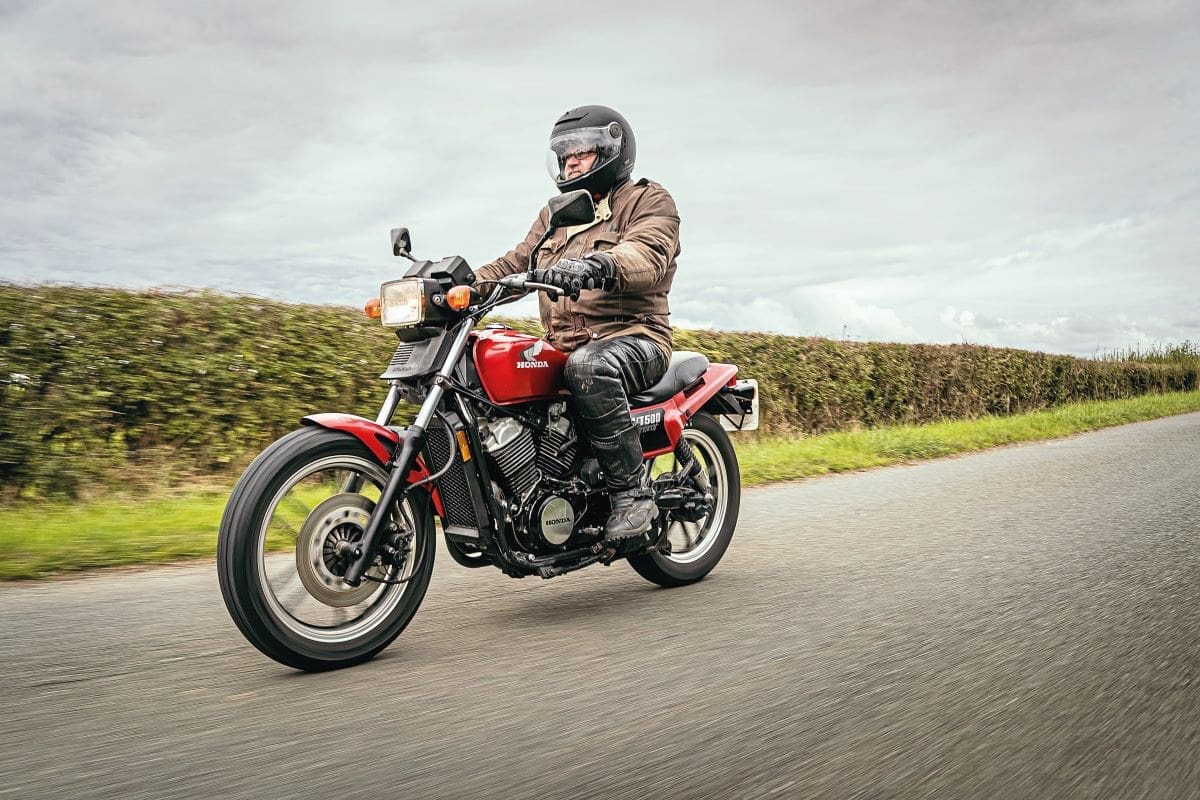
The VT500
Honda made some very curious decisions in the early 1980s and produced all manner of weird and wonderful motorcycles. One of its more controversial decisions was to dump its hugely popular CX500 V-twin, a motorcycle beloved of couriers, tourers and commuters (once the collapsing cam drive was sorted out). Honda dropped it as a 500 after six years in production. There had been a not entirely successful redesign of the CX in the meantime that looked as if it had been done by the Mattel toy corporation’s Hot Wheels department.
At this time, as well as the CX, it was flogging three other road-going bikes with vastly different power plants to the middleweight market. These were the solid but flawed CBX550, the light and hopelessly fragile FT500 single, and the overly complex and fabulous VF400/500. The official replacement for the CX500, the VT500, expanded choice even further and came in three very different offerings.
VT500E – the Euro option
Honda launched the VT500 into a crowded marketplace, just as motorcycle sales began to collapse in the US in 1982. In Europe it sold the VT500E, which had curious, angular styling and Honda’s terrible inboard front disc.
It would have been relatively easy to redesign the CX engine by rotating it through 90 degrees and sticking a chain final drive on it, but that wasn’t the Honda way. A new engine was needed for a new bike, and Honda – as usual – built one from the ground up. The new twin was a 491cc 52-degree inline Vee.
The VT500 engine had an oversquare bore of 71mm, a stroke of 62mm, and chain-driven single overhead camshafts operating the valve train. They dropped the four-valve heads of the CX in favour of three valves per cylinder, like the Honda Superdream, and used a heart-shaped combustion chamber, an arrangement that was supposed to increase torque. A pair of 34mm downdraft carbs were shoehorned into the gap between the cylinders, and both exhausts exited on the right a la Harley-Davidson. The engine was liquid-cooled, like the CX500. There were two spark plugs per cylinder, too, which was something to do with that heat generated by the rear cylinder.
Honda broke with convention when designing the crankshaft, too. Where most V-twins at the time shared a single crankpin, with the conrods sitting alongside each other on the same throw, the VT had a forged one-piece offset crank with two crank pins offset by 76 degrees, the idea being that the offset made the engine think it was a 90-degree twin. Vibration would, the theory went, be reduced considerably, and it was an idea that worked.
The VT500 engine could propel the rider at just over 100mph and had an impressive 9500rpm redline, but the average rider wouldn’t treat the Honda so cruelly.
There was a gear primary drive that was more compact and less prone to failure than a chain, a wet clutch, a six-speed box, and, wonder of wonders, a shaft drive. This had been a sensible addition on the transverse CX, but on the inline twin a shaft drive required a power sapping right-angled drive at the engine end. This engine was squeezed into a cradle frame. With very little room around the cylinders, the VT wasn’t easy to work on and getting the engine out and back in again would be a challenge, so Honda used a removeable section of right downtube to aid getting the engine out.
Most Honda twins of the period below 500cc had used spine frames with the engine as a stressed member, so the cradle was a perhaps a little backward-looking.
There was a long, thin radiator (that looks not a little like the one used on BSA’s new Gold Star) with a coolant reservoir behind the gearbox. Boring and bouncy twin shocks were used at the back and the swingarm ran in tapered roller bearings. It was box section on one side, with the shaft drive doing the job on the other, and there were air forks on the front, which took some care to set up. Over-pressurise them and the seals would blow.
On European models there was the troublesome enclosed disc on the front and, to the relief of many, a very conventional drum on the back. Euro-spec models also got a set of bolted and riveted together pressed aluminium Comstar wheels. And this was just in Europe.
The VT500FT Ascot
The Americans got two versions of the middleweight Vee. There was a custom styled VT500 Shadow, which had the air of a miniaturised ersatz Harley, and the VT500 Ascot, which had the air of, well, nothing else, really. The VT500FT Ascot was named after a California dirt track oval, akin to an oversized speedway track rather than a leafy horseracing venue in rural Berkshire… or, indeed, a noisy gas hot water boiler.
The FT stood for Flat Track, and in a curious marketing move the VT500 was sold alongside the stylistically similar FT500 Ascot single. Which must have made for interesting times for the customer who wanted to buy spares ‘for their Ascot’.
The FT500 was cheaper, slower, and more fragile than the VT500. The FT500 was also bit of a mechanical disaster if neglected and lingered in the showrooms long after Honda stopped making them. Even today, new FT500s turn up still in their crates at old-school US dealerships.
The VT500 Ascot, meanwhile, was a different kettle of fish. The VT engine was, despite its complexity, a goodie. Economically frugal, the VT motor was flexible and, given the fact it was burdened with the power-sapping shaft, it was a lively performer and ideal for urban jaunts and occasional mild off-roadery.
The VT Ascot needed little maintenance beyond regular servicing, and Honda had obviously decided that while we poor rain-soaked Europeans need such advances to stop in the wet, Californians did not require fully enclosed discs, so a single disc with a twin-piston caliper was bolted to a much more attractive alloy wheel than the Comstar. The back end used the VT500E drum and shaft and an alloy wheel that matched the front.
Using a shaft drive was a curious idea for a flat tracker, but it meant the rider could just turn a hosepipe on their grubby steed after a trip on the Wild West’s dirt roads, wipe it down, and put it away till next time. The VT wasn’t designed for long jaunts though, as the petrol tank was tiny with a range of just 90 miles.
Stylistically, it was a game of two halves. While in profile the Ascot was all swoopiness, there were lots of square edges from the other angle, not least in the handlebar area, with a rectangular instrument binnacle (or possibly trinnacle, given there was a temperature gauge too). The headlight was small and rectangular too, and there was a large plastic cover below it to hide all the wires and ancillaries. Like the FT500, the tiny, high-mount headlight brought its own problems, as there was not a great deal of room to jam all the wiring in.
The end…
It was sold between late 1982 and mid-1984. The writing was on the wall as Honda realised there were plenty of 1983 models still lurking in the dealerships unsold as it prepared to ship the 1984 models.
The crates with the ’84 V-twin Ascots began stacking up and Honda dropped the price to bargain basement levels to clear them out. Then both the FT models were dropped altogether as Honda buyers tightened their belts, while the Shadow, more popular in the US, lasted a few years longer.
The basic engine concept, however, did survive – and for many more years to come. The Transalp, NTV650, Bros 400 and 650, the Revere and the Hawk 650s and even the Africa Twin Deauville all had their origins in Honda’s unjustly ‘forgotten’ 1980s Vee.

SPECIFICATION
Honda VT500FT Ascot
ENGINE: 491cc liquid-cooled inline V-twin. Three valves per cylinder, twin chain driven SOHC COMPRESSION RATIO: 10.5:1 POWER: 50bhp @ 9000rpm GEARBOX: 6-speed FINAL DRIVE: Shaft FRAME: Steel-tubed double cradle SUSPENSION: Telescopic air forks, twin shock rear BRAKES: Twin 11in/28cm disc front and drum rear TYRES: 100/90-18 front 120/80-18 rear SEAT HEIGHT: 31in/790cm WHEELBASE: 58 in/1473mm WEIGHT: 416lb/180kg
SPECIALISTS
Somerset Classic Motorcycles
somersetclassic motorcycles.co.uk
CMSNL
www.cmsnl.com
OWNERS’ CLUB
Honda Owners Club (GB)
www.hoc.org.uk
Vintage Japanese Motorcycle Club
www.vjmc.com


